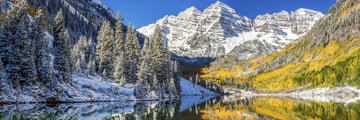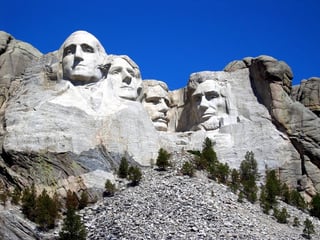Exploring Colorado’s ghost towns
Gold and silver mining was big business in late nineteenth-century Colorado, attracting hordes of starry-eyed prospectors and settlers who played a pioneering role in shaping and bolstering the growth of the West. Many of the settlements that sprung up as a result, often in some truly inhospitable locations, went boom and bust in a matter of years, leaving the state with one of the highest concentrations of ghost towns in the US: well over 1,500. Of these former mining towns a handful blossomed into some of Colorado’s prime modern-day tourist destinations (notably Leadville, Idaho Springs and Breckenridge), whilst others have since been cleanly wiped off the map without so much of a trace of their frenzied gold-rush days.
There are, though, around 640 classic ghost towns with preserved remains which can be visited on a fascinating bone-chilling journey through the state’s Old West past. Some have been entirely abandoned without a soul in sight. Others have burgeoned into popular tourist attractions, their beautifully-preserved structures attracting special protection status, along with museums, guided tours and a handful of permanent residents. Most of Colorado’s ghost towns are best visited in the warmer months as many become completely snowbound and cut off from the outside world during the winter – a stark reminder of why they were often abandoned in the first place. Of course, such a tour can also be combined with some of the state’s top natural attractions and most exhilarating adventure activities.

Here’s a rundown of Colorado’s coolest and creepiest ghost towns.
Independence
Independence is perched almost 11,000 feet up a high mountain pass. It is easily accessible from Colorado Highway 82 between Aspen and Independence Pass, though not in winter due to deep snow.
The town was established in 1879 after a prospector struck gold, subsequently attracting hundreds of other hopefuls along with dozens of businesses. The town was short-lived, however, owing in large part to its high altitude that effectively cut it off from the rest of the world for long periods during the harsh winters. The population dwindled through the 1880's and the last remaining residents eventually abandoned the town in 1899 following several severe snowstorms. They made their escape down the mountain to Aspen using makeshift skis constructed using the wood from their cabins.
At its peak, Independence was home to over 1,500 people and included many dwellings, along with a sawmill, five saloons and two boarding houses. Today, there are still a few eerily beautiful structures intact and the entire site is situated against a picturesque mountain backdrop. The town is owned by the Aspen Historical Society who offer informative tours throughout the summer months.

St. Elmo
Situated at 10,000 feet in the spectacular Collegiate Peaks near Buena Vista, St. Elmo is easily one of Colorado’s most popular and best-preserved ghost towns. Founded in 1880 after gold and silver was discovered in the nearby mountain, St. Elmo’s grew into a bustling mining hub of over 2,000 residents. It became a renowned hotspot for saloons and brothels and thrived well into the 1920's as hotels, dance halls, a newspaper office and even a town hall and schoolhouse were all constructed.
Today, the town’s Main Street, with its wooden storefronts and dust-laden road, looks straight out of an Old Western, remaining remarkably unchanged since the 1880s. There are more than 40 authentic structures to explore, including a saloon, store, post office, stable, blacksmiths and a couple of beautifully restored private homes. This ghost town is also reputedly haunted by an actual ghost who is said to keep guard over her spine-chilling former property. St. Elmo is perhaps surprisingly lively for an abandoned town. Along with attracting plenty of visitors, a handful of people still reside here permanently and there are even vacation houses available to rent if you fancy lingering to explore the surrounding area.

Vicksburg & Winfield
Located 2 miles southwest of Leadville down a steep clear creek canyon, the ghost town of Vicksburg was founded in 1867 after prospectors struck gold in the riverbed. In its heyday the town featured a general store, post office and several saloons. It is also distinguished by its tree-lined streets which were planted by the early settlers. There are still around 10 original buildings standing today and the Chaffee County Historical Society maintain an interesting museum for visitors keen to check out authentic artefacts and learn more about early mining lifestyle.
A little further along the same route you’ll come to the abandoned settlement of Winfield, nestled in the San Isabel National Forest. Gold mining thrived here for a short time and multiple stores, saloons and hotels were constructed to support the growing population. However, the mines quickly ran out of gold due to shallow deposits and the town ended up going bust after just three years.

Animas Forks
Northeast of Silverton, the haunting beauty of this former mining hub makes it one of Colorado’s best-loved ghost towns. Animas Forks was established in 1873 around the Gold Prince Mill and grew to a population of 500. Businesses moved in fast and at its peak the town featured an array of cabins, a general store, post office, saloon and even a local newspaper. Situated high in the San Juan Mountains at a chilly 11,200 feet and plagued by frequent avalanches, the town was eventually abandoned by 1920.
Animas Forks boasts a protected status, including a listing on the National Register of Historic Places. It features a handful of restored buildings, most notably the impressive two-storey Duncan House which is famed for its huge bay windows. The roads leading in are pretty rough and a four-wheel drive is essential to access this town. It can be quite a trek to reach, but you’ll be rewarded with stunning mountain scenery, an exhilarating off-road experience and one of the best-preserved ghost towns in the state.

Ashcroft
Only 10 miles from Aspen, the town of Ashcroft was founded in 1880 following the discovery of silver in Castle Creek Valley. It soon swelled to 3,500 residents, along with six hotels, two newspapers, a school, sawmills and no less than 20 saloons to support the thriving population. However, mining was short-lived and the town faded by the turn of the century as residents moved on to richer pastures. Ashcroft did however experience a short revival in the mid-twentieth century when it was used as a mountain training outpost by the US Army.
What’s left of the town today is considerably reduced by comparison, but what does remain is remarkably intact. The Aspen Historical Society protects the town and runs informative tours of the buildings, including the jail, livery stable and saloon. The natural setting alone makes Ashcroft well worth a visit, with thick aspen groves (best experienced in fall) and a backdrop of snow-capped peaks all just a short drive from Aspen.

Dearfield
A little different from many of Colorado’s mountain ghost towns, Dearfield was established in the early twentieth century as an agricultural community on the plains east of Greeley. It’s famed for being the only all-black settlement in the state and provides a captivating glimpse of early settler life on the plains. By 1921, the town had attracted over 700 African Americans hoping to carve out prosperous lives farming the land. However, the Great Depression and Dust Bowl years scuppered these dreams and the town gradually faded until the last resident died in 1973. Today, only three buildings still stand: the lead colonists’ property, a gas station and diner. However, Dearfield is listed on the US National Register of Historic Places and efforts are currently underway to restore and revive the site.

Teller City
Located southeast of Walden in Colorado’s North Park area, Teller City was once a booming silver mining camp that housed over 1,500 residents in its 1880's heyday. Hundreds of log cabins, 27 saloons and a 40-room hotel sprung up to accommodate the miners and their families, but things went downhill fast after the silver bust and the town was abandoned by 1902. This remote site is situated at just over 8,000 and set amid a peaceful landscape of dense forests and numerous lakes and streams. It’s perfect for exploring on foot and there’s a designated ¾ mile-loop trail that takes visitors on a spooky tour around the scattered cabin remains and historic artefacts of this once bustling town.
More Inspiration
Recommended holidays
















